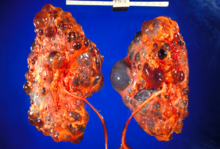User:Mr. Ibrahem/Polycystic kidney disease
| Polycystic kidney disease | |
|---|---|
| Other names | Polycystic kidney syndrome, kidney - polycystic[1] |
 | |
| Severely affected polycystic kidneys removed at time of transplantation | |
| Specialty | Nephrology |
| Symptoms | Flank pain, blood in the urine, headaches, growth failure[2][3] |
| Types | Autosomal dominant polycystic kidney disease (ADPKD), autosomal recessive polycystic kidney disease (ARPKD)[4] |
| Causes | Genetic mutation[4] |
| Risk factors | Family history[4] |
| Diagnostic method | Medical imaging, genetic testing[2][3] |
| Differential diagnosis | Multiple benign simple cysts, medullary sponge kidney, tuberous sclerosis[5] |
| Treatment | Lifestyle changes, blood pressure medication, dialysis, kidney transplant[4] |
| Prognosis | ARPKD 30% risk of early death[3] |
| Frequency | 1 in 700 (ADPKD), 1 in 20,000 (ARPKD)[4] |
Polycystic kidney disease (PKD, PCKD) is a genetic disorder that results in many cysts growing within the kidneys.[4] They may form before birth, during childhood, or in adulthood.[6] When cysts develop before birth growth failure or breathing problems may occur.[3] Otherwise symptoms may include flank pain, blood in the urine, and headaches.[2] Complications may include kidney failure, high blood pressure, liver cysts, aortic aneurysm, and cerebral aneurysm.[4]
It occurs as a result of a genetic mutation.[4] Generally this is inherited from a persons parents though may rarely occur spontaneously during early development.[4] The cysts form from non-functioning tubules that have fluid pumped into them.[7] There are two types autosomal dominant polycystic kidney disease (ADPKD) and autosomal recessive polycystic kidney disease (ARPKD).[4] The diagnosis maybe confirmed by medical imaging or genetic testing.[2][3]
There is no cure.[2][3] Treatment may include lifestyle changes and medications to reduce blood pressure such as ACE inhibitors.[4] Kidney failure may be managed with dialysis or kidney transplant.[4] About 30% of those with ARPKD die within the first few weeks of life.[3] More than half of people with ADPKD develop kidney failure by the age of 70.[2]
PKD affects about half a million people in the United States.[4] ADPKD affects about 1 in 700 people and ARPKD affects about 1 in 20,000 children.[4] Males and females are affected equally frequently[4] The condition was first described in the 16th and 17th centuries.[8]
References[edit]
- ^ "Polycystic kidney disease". MedlinePlus Medical Encyclopedia. Archived from the original on 2016-07-05. Retrieved 2015-07-30.
- ^ a b c d e f "Autosomal Dominant Polycystic Kidney Disease | NIDDK". National Institute of Diabetes and Digestive and Kidney Diseases. Archived from the original on 10 January 2021. Retrieved 24 January 2021.
- ^ a b c d e f g "Autosomal Recessive Polycystic Kidney Disease | NIDDK". National Institute of Diabetes and Digestive and Kidney Diseases. Archived from the original on 25 January 2021. Retrieved 24 January 2021.
- ^ a b c d e f g h i j k l m n o "What Is Polycystic Kidney Disease? | NIDDK". National Institute of Diabetes and Digestive and Kidney Diseases. Archived from the original on 21 January 2021. Retrieved 23 January 2021.
- ^ Akbar, S; Bokhari, SRA (January 2020). "Polycystic Kidney Disease". PMID 30422529.
{{cite journal}}: Cite journal requires|journal=(help) - ^ Cramer MT, Guay-Woodford LM (2015). "Cystic kidney disease: a primer". Adv Chronic Kidney Dis. 22 (4): 297–305. doi:10.1053/j.ackd.2015.04.001. PMID 26088074.
- ^ Subramanian, S; Ahmad, T (January 2020). "Polycystic Kidney Disease Of Childhood". PMID 30725822.
{{cite journal}}: Cite journal requires|journal=(help) - ^ Kenny, Thomas D.; Beales, Philip L. (2013). Ciliopathies: A reference for clinicians. OUP Oxford. p. PT249. ISBN 978-0-19-163337-9. Archived from the original on 2021-08-29. Retrieved 2021-01-24.
